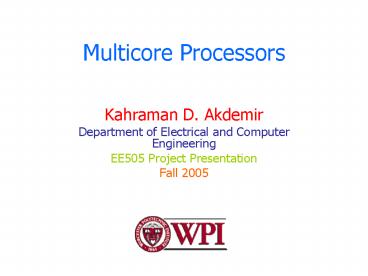Multicore Processors PowerPoint PPT Presentation
1 / 11
Title: Multicore Processors
1
Multicore Processors
- Kahraman D. Akdemir
- Department of Electrical and Computer Engineering
- EE505 Project Presentation
- Fall 2005
2
Multicore Processors
- Processor performance
- Moores Law
- Decreasing transistor sizes
- Increasing number of transistors
- Decreasing chip sizes
Higher clock rates More complex Faster
microprocessors
Fig. 1 Moores Law Transistors on a chip double
every 2 years(Gelsinger, 2001)
However Transistors cant shrink forever
Several problems with this approach
Performance increase is slowing down
1990-2000 60 per year 2000-2004 40
per year
SOLUTION MULTICORE PROCESSORS
3
Outline
- Limitations of single core architectures
- Power consumption
- Heat generation
- On chip wires and interconnect latency
- Limited parallelism
- Design time and complexity
- Multicores (CMPs) as a solution
- Structure of multicore processors
- Advantages and improvements
- Task management and parceling
- Multicore examples
- Multicore related results
- Multicore VS single core
- Multicore VS Superscalar SMT
- Impact of number of cores and threads
4
1- Limitations of single core architectures
- Power consumption
- Smaller gates
- Higher clock rates
- 2-3 power increase per 1 performance increase
- Leakage power scales 5X in each technology node
- Heat generation
- Extensive heat rejection
- of multiple kilowatts is
- undesirable from a thermal
- perspective
Fig. 2 Lead microprocessor power increases beyond
expected(Gelsinger, 2001)
5
1- Limitations of single core architectures
- On-chip wires and interconnect latency
- Faster gates and larger chips
- On-chip wire delay increases
- Interconnect delays become more critical
- Limited parallelism
- Finite amount of ILP
- Interdependent instructions
- Design time and complexity
- Hard to design
- Large number of transistors
- Complex methods to increase ILP
6
2- Multicore processors as a solution
a) Structure of multicore processors
Fig. 3 Stanford HYDRA Multicore
structure(Hammond, 2000)
7
2- Multicore processors as a solution
- Advantages and improvements
- Performance increase by means of parallel
execution - Power and Energy efficient cores (Dynamic power
coordination) - Minimized wire lengths and interconnect latencies
- Both ILP and thread level parallelism
- Reduced design time and complexity
- Task management and parceling
- Usually operating system distributes the
application to the cores - Can be done according to resource requirements
- Multicore examples
- AMD Opteron Enterprise, Athlon64
- Intel Pentium Extreme edition, Pentium D
- IBM Power 4, Power 5 and Sun Niagara
8
3- Multicore related results
a) Multicore VS single core
Fig. 4 Multicore VS Single core(Geer, 2005)
9
3- Multicore related results
b) Multicore VS Superscalar SMT(Simultanoues
multithreading)
Fig. 5 Multicore VS Superscalar VS SMT(Hammond,
1997)
10
3- Multicore related results
c) Impact of number of cores and threads
Fig. 6 Impact of number of cores and
threads(Chaudry, 2005)
11
Conclusion
- To Sum Up...
- Improvement needs
- Multithreaded and parallel software/applications
- Improved packaging for high number of I/O pins
- Cash size VS possible number of cores
- QUESTIONS?

